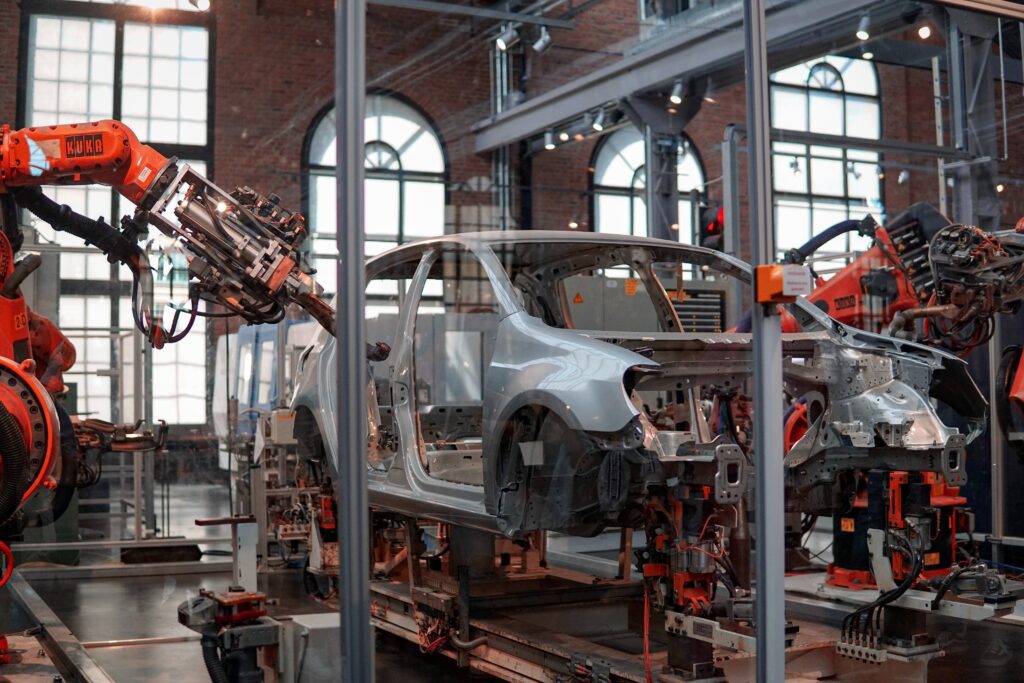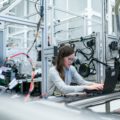That is, even robots have a soul ...
Interview with Comau nj 220 by Pietro Varvello

I meet Comau nj 220 in a bar in Grugliasco, western suburb of Turin, once an area teeming with warehouses occupied by the automotive industry. He wants me to call him Antonio and I find him confused about his professional future, a feeling quite consistent with the atmosphere in this industrial suburb. He asked me for a coaching meeting to raise awareness of the moment he is living and identify the most appropriate actions to face the near future, so as to transform that pinch of fear linked to change into energy. I explain to him that I know little about industrial robotics and I would not be able to suggest technical solutions to better adapt to the new demands of the market, but Antonio explains to me that it is enough for you to listen to him and help him in this moment of discontinuity between the activities he has carried out. up to now with great professionalism and efficiency and those that lie ahead for new car productions.
How are you Antonio?
I want to be honest: on the one hand I am worried about the changes I will have to face, on the other I am excited by this new challenge.
What challenge are you talking about?
Of the new electric car market, an event that is radically changing traditional production, involving the entire production chain starting with components.
Explain yourself better, what does it mean to be worried and excited at the same time?
I was born in Comau several years ago and from the beginning I never had any doubts about my technical characteristics and my operational leadership. You should know that Comau is the acronym of COnsorzio MAcchine Utensili, a company born in the 70s and formed by the engineers and companies of Turin who had contributed to the construction of the historic Volga car plant in Russia. Over the years the company has grown into a multinational with numerous operating centers and production plants in North and South America, Europe and Asia. The Group has subsequently diversified into new businesses such as digital and electrification and in recent years, following an approach defined as "HUMANufacturing", has developed innovative technologies for the "factory of the future" where "collaborative" robots serve intelligent automation with a view to Industry 4.0, the most advanced frontier in collaboration between man and machine.
You are therefore part of a company of excellence: so why are you confused?
As I mentioned, for some years our design engineers have been asking me to develop new features and operations that use increasingly simple and intuitive commands, such as looking at an object, touching a particular point in space, listening to voice recognition operations and reproducing complex actions. , such as automating the process of checking and checking a car's infotainment system. Just think that a modified version of mine is already in production today, capable of carrying out most of the test activities inside the car, with great efficiency, traceability and repeatability of the procedure. These changes are happening very quickly and this is the reason for my confusion: I was originally designed and developed for the lines of the traditional car, where for many years I have worked quietly inside my cage (i.e. my comfort zone). and where I assembled engines, fitted carburetors, exhaust pipes, etc. You must know that I have always been a robot in great demand by the traditional automotive industry thanks to my 6-axis movements, a load capacity at the wrist of 220 kg., An outreach of over 2.7 meters; and have been designed for a very large number of operations ranging from assembly and assembly of components, to spot welding and laser cutting, to polishing and brushing up to the enslavement of other machines, to packaging and packaging. Modestly, even if I don't like to brag, in the panorama of industrial automation, and especially in automotive production, I am an absolute leader, admired and envied even by many of Comau's competitors.
So what's the problem?
I repeat that the problem is mostly psychological and arises from the type of automation demand of the new factories, a scenario that is changing at a speed that even I was not prepared for. But do you know what an electric car is like? In reality, let's not even call it a "car" or "automobile": I would rather call it a computer with wheels. And the new factories? What do they have in common with traditional ones? Have you seen how the staff working there is changing, the number, skills and specializations required? I was designed to collaborate with traditional workers, where people were at the center of the production process and where automation was made efficient and safe thanks to collaborative robots like me who worked obediently inside their protective cages. The new factories have fewer men and even fewer robots! Hence my concern and also from the fact that I am convinced that many of my operational features, built over many years of sacrifices, adaptations and improvements, will have to undergo significant adaptations to continue to operate efficiently and productivity. And then, being a "mature" robot, I wonder if I will even manage psychologically to continue working alongside this new generation of robots designed ad hoc and dedicated to the assembly of electric cars and more generally to the whole car of the future.
At the beginning you spoke well of Comau and therefore do not fear that its engineers will not be able to find solutions to allow you to continue to operate at your best even in these new realities ...
Look, I'm not just thinking about my personal situation! I am not a selfish robot and I am also thinking about the impact that the electric car will have on the supply chain of components I have known all these years! We are speaking only in Italy of a sector of 2,200 companies, over 160 thousand employees and 45 billion in revenues that will have to reorganize and restructure heavily to take advantage of this new challenge. A recent study by Roland Berger carried out for Anfia was quite eloquent: the 85% of the components of the powerplant in which about 70 thousand employees are concentrated (almost half of whom are located in Italy) risks being displaced by these changes. And then, if by chance you didn't know it, the pure electric “engine”, that is, without the assistance of a traditional supporting engine (in hybrid or plug-in mode), has a significantly lower quantity of components. We also ask ourselves where the new components are coming from, including electric batteries, and in which factories they are already assembling them. For the first time, a future is being built in the automotive industry in which Europe is no longer central. Finally, I would add that if Volkswagen estimates that around 30% fewer working hours are needed to produce an electric car, we will have to foresee fewer robots in perspective, but also a significant reduction in blue-collar workers (which in the meantime will become more and more whites)!
Certainly, training and retraining courses will be needed for blue-collar workers and significant reprogramming for you and your "elderly" robot colleagues ...
You have to help me because I still want to participate in this new challenge! I want to overcome this psychological disorientation and still participate as a protagonist in this new market green, made up not only of hybrids and plug-ins, but also of electric ones, a market that in just a few years has gone from a marginal niche to a 38% of registrations in Europe (Acea data, first half 2021, including the UK). We are witnessing a real explosion in the demand for electromobility which, if on the one hand it will leave many companies and even some districts in the field, on the other hand it is opening up new fascinating scenarios for industrial automation as well. Consumers are moving towards cleaner, greener and more sustainable vehicles and the new generations no longer see the car as a physical product, but use it mainly as a service, through car sharing and car-pooling.
What are you going to do at this point?
I would say that there are few alternatives: I have to get back to studying with commitment and humility! Some of our engineers have proposed me to experiment with my functionalities in new applications of Mechatronics and Artificial Intelligence. I will have to learn how to use new computer vision systems that will allow me to become a true white-collar partner. Electric mobility is progressively raising automation and efficiency, as it requires intelligent, environmentally friendly, zero-impact and networked production sites. They anticipated that the digitalization of these new factories is extending to all sectors of production, with a high level of cooperation between man and machines and where workers are exempt from physically demanding operations and driverless transport systems (FTS) transfer the components needed completely autonomously, thus revolutionizing the factory workflow. Just think that my design engineers have promised me that I will be able to have safety functions so sophisticated that they eliminate the need for protective barriers, that is, the cages in which they had confined me all these years! I will finally be able to work alongside the man with no more sense of inferiority!
Now I see you a little more relaxed, motivated and also involved in the next changes ...
It did me good to talk to you because you helped me discover new scenarios and opportunities: by the way, do you know that they also told me that they are designing an autonomous robot capable of recharging electric cars, turning every parking lot into a charging point? They are robots of a new concept that pull the mobile batteries to the car and take care of all operations without external intervention. I am a little jealous because these new robots are cute and colorful and also very well designed, a feature that until now my designers had never taken into consideration!
Article published in the April 2022 issue of Harvard Business Review Italia.






